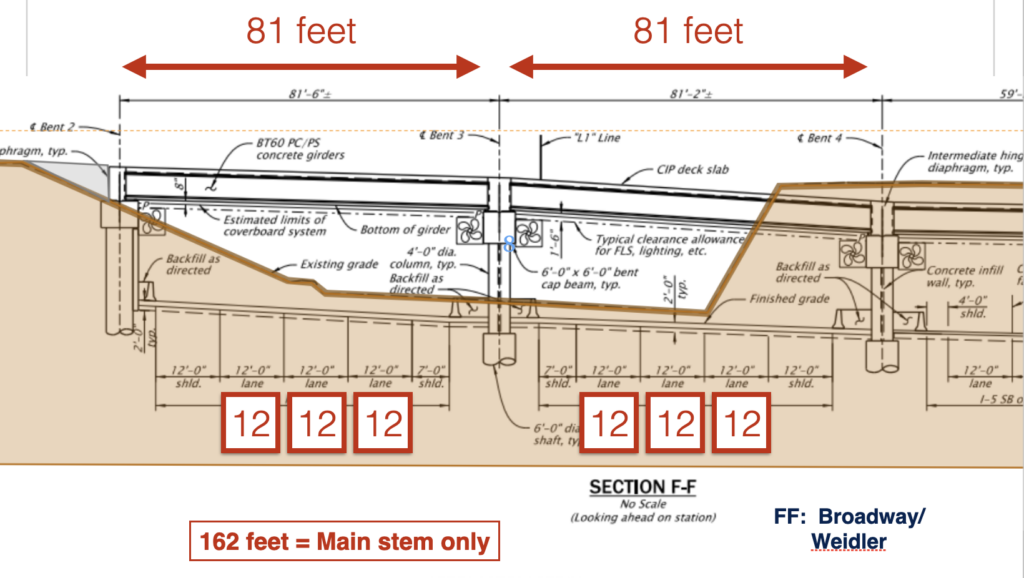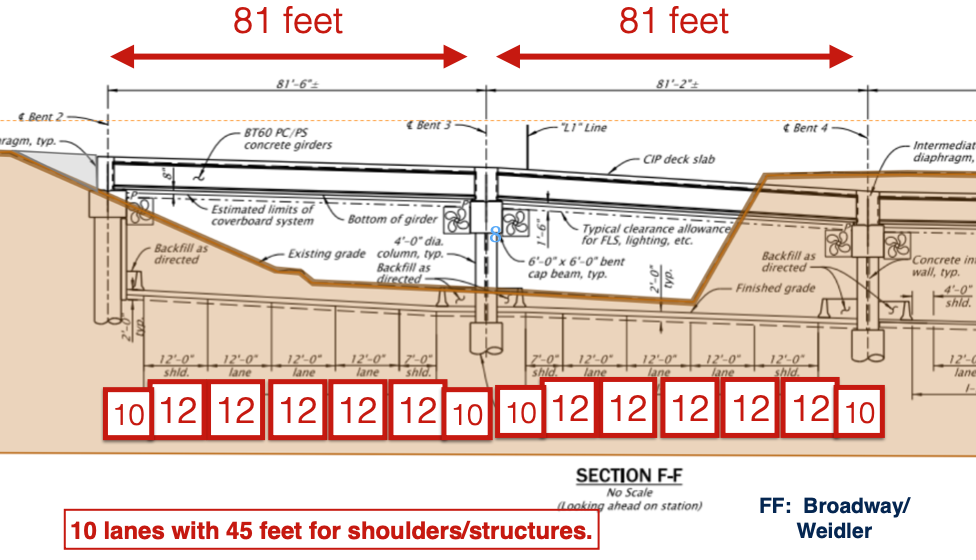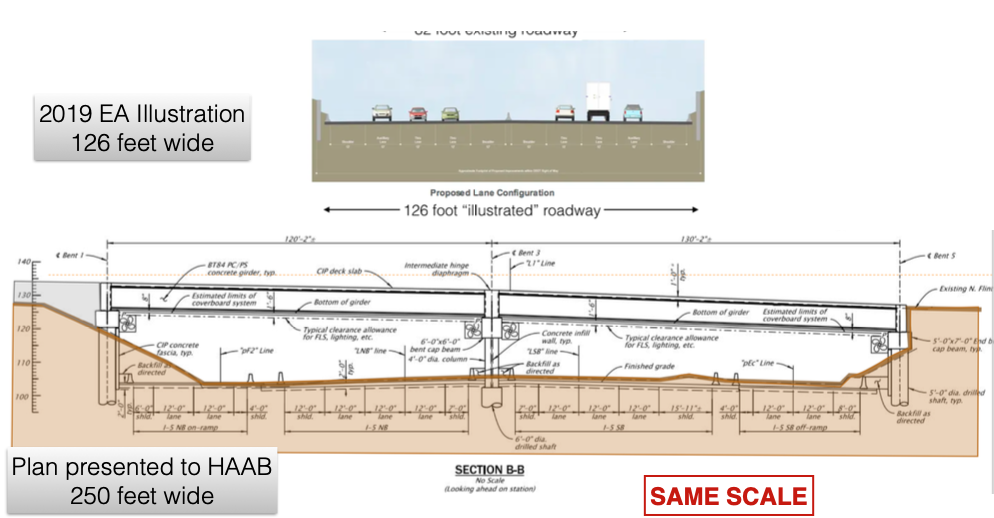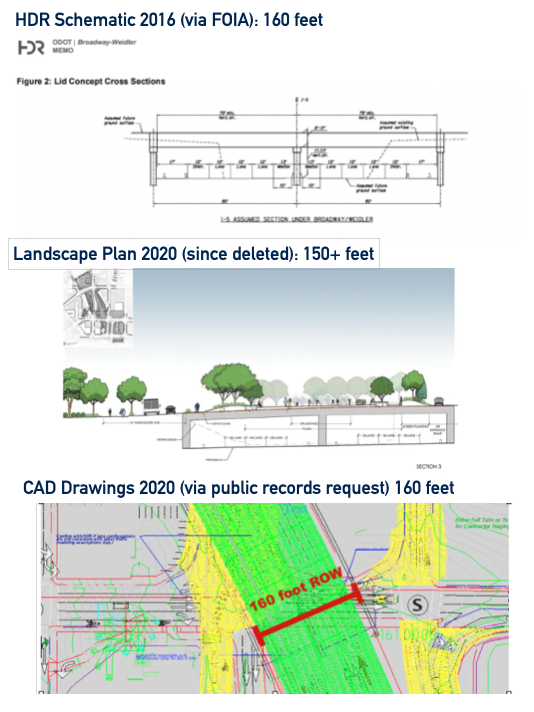Secret ODOT plans obtained by City Observatory show ODOT is planning a ten-lane freeway through the Rose Quarter
Though the agency claims its “just adding one auxiliary lane” in each direction, the I-5 Rose Quarter project is engineered with a 160-foot wide footprint, enough for 10 full travel lanes and extra wide shoulders.
In places the I-5 Rose Quarter project would be as much as 250 feet wide. ODOT’s plans are to double or triple the width of the roadway from its current 82 feet.
ODOT plans are drawn to conceal the massive width, with cartoons and misleading “Not to scale” drawings. The project’s 2019 Environmental Assessment implied the roadway would be only 126 feet wide, but these newly obtained plans confirm it will be vastly wider.
Once built, ODOT could re-stripe this massive roadway for 10 lanes in an afternoon.
The agency has not disclosed the true size of the project, and its Environmental Analysis doesn’t consider the traffic, pollution and safety effects of a ten lane structure.
The project’s massive width—not its covers—are the real reason for the project’s huge expense, which has exploded from $450 million in 2017 to an estimated $1.9 billion today.
ODOT has ignored its own international expert consulting engineers who called for a much narrower roadway, and alternating refuges in the tunnel section to minimize expense.
For years, we’ve been pointing out the lengths that the Oregon Department of Transportation (ODOT) has gone to in concealing the width of it’s I-5 Rose Quarter “Improvement” Project. ODOT claims that it is merely adding one “auxiliary lane” to the freeway.
But documents—newly obtained by City Observatory from a public records request—show that the I-5 Rose Quarter Freeway will be as 160 feet wide, and in places much as 250 feet wide as it slashes through Northeast Portland. That’s about two to three times wider than the existing 82 foot roadway.
The proposed Rose Quarter I-5 mainline is 160 feet wide, enough for a ten-lane freeway
As it passes under Broadway and Weidler streets, the main stem of the widened I-5 freeway (excluding the separate on- and off ramps) is a full 160-feet wide according to the previously unreleased ODOT drawings. The ODOT diagram purports to show the number of lanes and the width of shoulders, but if you look closely, there’s something fishy going on here. First, the fine print at the bottom of the drawing says “No Scale” which is an admission that despite the measurements shown, this is not a true scaled drawing of the project. That becomes clear when you start comparing the measurements indicated for the lane and shoulder markings with the overall width of the project. Let’s take a closer look at the plans.
Both the Northbound and Southbound clear-span areas is about 81 feet wide. According to ODOT’s labeling there are just three 12-foot wide travel lanes in each of these 81 foot openings, meaning that 45 feet of the width under the span isn’t actually being used for travel lanes and is available for shoulders. We’ve added the red annotations to the ODOT diagram below.

Despite ODOT’s misleading and incomplete labeling of this diagram, its apparent that the project will easily allow construction of a 10-lane freeway (with five through travel lanes in each direction) at Broadway-Weidler. We’ve further annotated the ODOT drawing to show full 12-foot travel lanes and ten-foot inside and outside shoulders.

ODOT’s own consultants, the international design firm ARUP recommended narrower lanes (11 feet) and much narrower shoulders (as little as three feet) to minimize project costs. Elsewhere in the project, ODOT is using 11-foot through-travel lanes and narrower shoulders. If it used followed standard industry practice here, ODOT could stripe the freeway for twelve-travel lanes, and urban-standard freeway shoulders.
The freeway will be as much as 250 feet wide
While the mainstream of the freeway at Broadway-Weidler will be 160 feet wide, the project is actually even wider at its North end. As it crosses under Hancock Street, the I-5 freeway will be 250 feet wide—more than three times wider than the current roadway, and more the twice as wide as depicted in the project’s 2019 Environmental Assessment. ODOT provided an image of the project that provides some key details, including the fact that the two spans of the overpass will be 130 feet and 120 feet wide. On this section, the freeway consists of two southbound offramp lanes, six travel lanes (three in each direction) and two northbound on-ramp lanes, plus considerable additional room for shoulders as well as other space which is not labeled (more on that in a moment).

The Rose Quarter project so expensive because its too wide
The reason the Rose Quarter project’s budget has exploded from $450 million just six years ago, to as much as $1.9 billion today is because of the bloated size of the proposed roadway. Building a roadway that is two to three times wider than thecurrent I-5 freeway is the primary driver of high costs, according to ODOT’s consultants ARUP. The overly wide freeway requires enormous beams to support the lengthy overpasses: the girders (BT84) for the overpasses have to be about 7 feet tall. To accommodate the wider footprint, and provide sufficient vertical clearance over the roadway, ODOT will have to excavate an enormous area, and dig deeper to lower the level of the freeway (notice the brown area to be removed on the Broadway-Weidler diagrams). And while ODOT wants to blame the covers for the high cost of the project, its actually the grossly oversized width of the freeway that drives up the cost of both the roadway, and the covers: a narrower freeway would be vastly cheaper to cover. As part of the Interstate Bridge project, WSDOT is proposing to build an acre-sized cover over I-5 to connect downtown Vancouver to historic Fort Vancouver for a cost of less than $40 million.
ODOT has actively concealed the width of the Rose Quarter Project
ODOT has undertaken multiple and sustained efforts to hide the actual width of the highway widening. They’ve falsely repeated the Orwellian claim that they’re adding a single auxiliary lane in each direction.
They’ve published false and misleading “not to scale” illustrations that understate the true width of the project as part of the federally required Environmental Assessment.
Instead of presenting the actual plans, ODOT has repeatedly published misleading, not-to-scale illustrations purporting to show the width of the project. The original 2019 Environmental Assessment contained this drawing. It didn’t show the actual overall width of the project, but labeled lane and shoulder widths that together totalled 127 feet

In the Supplemental Environmental Assessment released late in 2022, ODOT updated and repeated this same tactic, producing two new illustration). It shows the existing alignment and the proposed allignment, as follows. The fine print at the bottom says “not to scale), but the diagram make the proposed project look narrower than the existing roadway.
City Observatory and others have long pointed out that ODOT is planning a much wider roadway at the Rose Quarter than it lets on. In 2020, the Oregon Transportation Commission directed ODOT staff to provide City Observatory with information about the actual width of the freeway. When pressed to provide details, and actual overall width measurements, ODOT provided elliptical and disingenuous responses to specific written questions asking for a statement of the project’s actual width. Here is an image of ODOT’s 2021 written response to a question asking the width of the project.

There is not a single number mentioned. Even when explicitly directed by the Oregon Transportation Commission to say how wide the road would be, ODOT officials dissembled and obfuscated, failing to reveal information that was clearly known to them.
In 2021, City Observatory obtained, via Freedom of Information Act requests and other sources, plans produced by ODOT showing that the project was actually designed to be 160 feet wide. These internal documents date back to 2016, and show a decision on project width was locked in by ODOT staff for years–just not revealed to the public.
Now, the latest plans for the Rose Quarter project show that it will be, at least in places, more than 250 feet wide. As before, these are documents that have not been released to the public until ODOT was forced to provide them via a public records request. In July, 2023, ODOT initially insisted on being paid more than $2,000 to release these records, asserting that their release to the group No More Freeways was “not in the public interest.” After an appeal to the Oregon Attorney General’s office, the records were released without charge. ODOT continues to treat the actual size of this hugely expensive project as a state secret, something the public is not allowed to know.
ODOT’s persistent efforts to conceal the true width of the proposed I-5 Rose Quarter project are an attempt to cover up the reasons for the extraordinary cost increases and un-disclosed environmental impacts of this project. A 160- to 250-foot wide roadway will further divide the neighborhood—repeating and aggravating the historic harms ODOT has inflicted on Albina. The ten through lanes this widened roadway will enable will produce additional traffic and pollution, and it will pour this added traffic onto nearby city streets, creating safety problems and turning nearby areas into hostile, traffic-burdened places, inhospitable to people and new development. ODOT has failed to look at a right-sized solution—simply capping the existing highway, or only widening it enough to accommodate the single additional auxiliary lane they say they want (something that could be accommodated in a roadway perhaps 24 feet wider than the existing 82-foot wide roadway).



